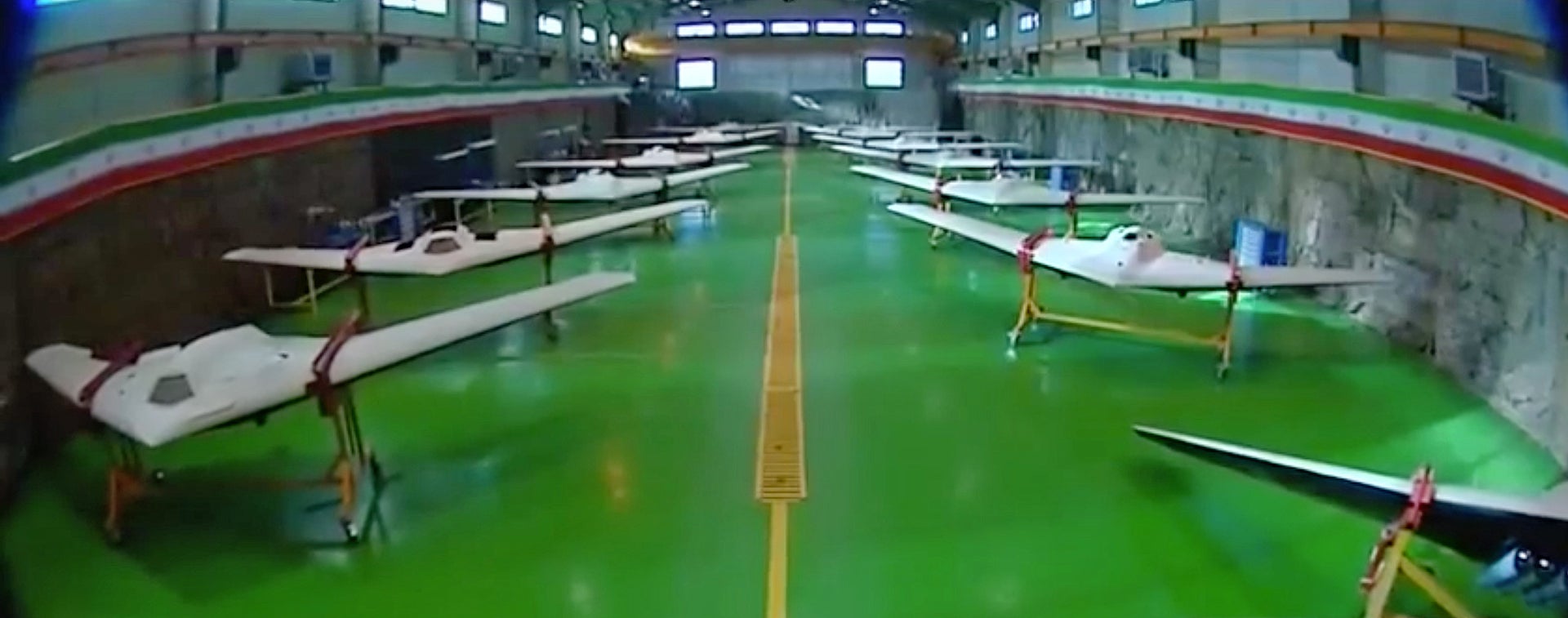Iran is once again showing off its “latest and greatest” in warfighting capabilities. A couple weeks ago, they unveiled this crazy looking catamaran, and now they’re showcasing their inventory of drones—many of which they claim have been reverse-engineered from captured craft (and they have stumbled upon a bunch of those). This new video, which ran on Iranian state television, specifically focuses on what appears to be a small fleet of their own versions of the American RQ-170 Sentinel.
Iran’s claims of reverse-engineering the RQ-170 go back half a decade, from shortly after the stealthy spy drone fell into Iranian hands. Although it’s all but certain that the Russians and the Chinese have had access to the captured stealth drone, and Tehran’s best aerospace minds have clearly explored every nook and cranny of the craft—including accessing at least portions of its memory banks—the idea that Iran has faithfully reproduced even a significant portion of the aircraft is unlikely.
Shown at one point in the video are the three Sentinel-like craft, all of which we have seen before. One is a small, radio-controlled scale model of the RQ-170, the other a full-sized aerodynamic scale replica that may have also been used for basic radio-controlled flight testing. The third one, which looks like it has seen better days, is the real McCoy—the same craft that Iran captured after it crashed in the country in late 2011. Clearly every one of its hatches have been opened and every system fully examined, as much of the seam-sealing tape and radar-absorbent coatings used to decrease the aircraft’s radar signature have been removed.

Later in the video we see what looks like a fleet of subscale RQ-170 knock-offs stored on cradles in a hangar. Although this is an impressive sight at first glance, upon closer inspection they appear to be nothing more than prop-powered flying wings with a similar shape to the RQ-170. One, on the left side of the hangar, does appear to have a similar grated air intake as the real RQ-170, but this is likely just a different cowling, haphazardly installed to give the appearance that Tehran has a jet-powered version of this new type of drone. In fact, from one angle you can see there is nothing but an empty void inside.
We also see what looks like the underbelly of one of these aircraft loaded with air-to-ground missiles. Obviously this configuration largely negates the advantages of a stealthy flying wing design, and what would provide targeting for those missiles remains unclear. Their method of mounting also looks suspect. In fact, the whole setup looks hastily mocked up, and not representative of a real capability. Additionally, none of these supposed new unmanned combat air vehicles (UCAVs) are seen sitting on their own undercarriage. They probably lack this feature entirely; instead, these much lighter and smaller airframes are likely sling-launched, or use a booster to go airborne.

In the end, copying the general shape of the RQ-170 is one thing, and if Iran can get a flying wing aircraft to maneuver reliably in a stable manner, that is somewhat impressive. But a good deal more goes into the RQ-170’s stealth design and capabilities than just its basic shape. These include the application of radar absorbent materials, the ability to precisely construct large and complex composite structures, acquiring an efficient jet powerplant suited for the medium-altitude, medium-endurance (MAME) mission profile, as well as implementing the many subsystems needed for it to accomplish its mission. These include electronic surveillance and electronic warfare systems, and a highly advanced autopilot, mission-planning, and control system and communication architectures. Not to mention a tailored sensor suite that can fit inside the RQ-170’s small airframe. The list goes on and on.
Slapping a reciprocating engine and prop onto the tail of these drones sure won’t help when it comes to radar signature control, either. Not to mention that the RQ-170s low probability of intercept, satellite data-links, and command and control software and infrastructure are not something Iran can simply examine and make happen on their own in a couple of years. There is also the question of these drones’ sensor payload, as there appears to not be any.
What we’re most likely seeing here are light unmanned aircraft that use line-of-sight command and control architecture that simply have a shape reminiscent of the RQ-170. If nothing else, the lack of landing gear, internal weapons bay, and a sensor suite, along with the simplicity of their propulsion system, points to the real possibility that these aircraft could be used as semi-expendable unmanned aircraft—aka suicide drones.
Under such a concept they would be sent to collect electronic intelligence on the enemy’s electronic order of battle (namely radar and SAM sites) using relatively simple passive sensors, and they could even be used as decoys to stimulate and confuse those systems. They could also carry an internal charge, allowing them to home in on certain electromagnetic emissions autonomously, and to detonate upon impact with the emitter.
This concept has already been widely implemented by Israel, and its tactical relevance for Iran is clear. Additionally, a small electro-optical camera can be added to these craft, adding reusable surveillance capabilities and the ability to attack targets of opportunity that are not emitting electronic emissions, including vehicles and people.
However, even if these drones are capable of this type of mission set, calling them some sort of advanced UCAV is just another laughable propaganda ploy by Tehran.
Contact the author: Tyler@thedrive.com
